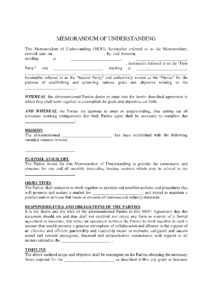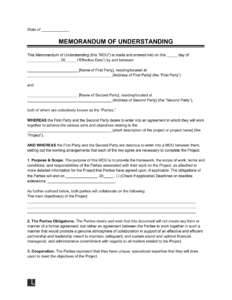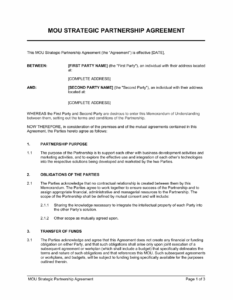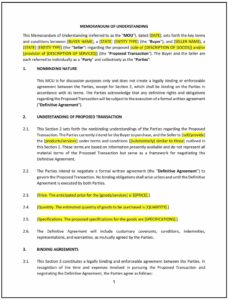Ever found yourself in a situation where you and another party are keen to work together, but it’s not quite time for a full-blown, legally binding contract? Perhaps you’re exploring a new partnership, initiating a project, or simply want to clarify intentions before committing to anything formal. This is precisely where a Memorandum of Understanding, often shortened to MOU, comes into play. It’s a fantastic tool for setting the stage and making sure everyone is on the same page.
Think of an MOU as a gentle handshake on paper, outlining a mutual understanding and a shared path forward without the strict legal ramifications of a contract. It’s about documenting good faith and a common goal, providing a clear reference point for all involved. And when you’re looking to put one together, having a reliable basic memorandum of understanding template can save you a lot of time and ensure you cover all the essential bases.
What Exactly is an MOU and Why Do You Need One?
At its heart, a Memorandum of Understanding is a document that expresses a convergence of will between two or more parties, indicating an intended common line of action. Unlike a contract, an MOU is generally not legally enforceable. It doesn’t create legal obligations or rights, but rather signifies a serious commitment to collaborate and work towards a shared objective. It’s a declaration of intent, a framework that guides future discussions and activities.
You might be wondering, if it’s not legally binding, what’s the point? Well, its strength lies in its ability to foster trust and clarity. By formally outlining expectations, roles, and responsibilities, an MOU helps prevent misunderstandings down the line. It serves as a psychological contract, a record that all parties have agreed to certain principles and steps. This shared understanding can be incredibly valuable, especially in the early stages of a collaboration where flexibility is still key.
The beauty of a basic memorandum of understanding template is that it streamlines this process. Instead of drafting a document from scratch, you have a pre-structured framework that prompts you to consider all critical aspects. It ensures that no important detail is overlooked, from the names of the participating entities to the specific goals you hope to achieve together. It’s about building a solid foundation for any future formal agreements.
Let’s look at some core components you’ll typically find in such a template, elements that help lay out the groundwork for any successful collaboration:
-
Identification of Parties
-
Purpose or Objectives
-
Scope of Work or Activities
-
Roles and Responsibilities
-
Duration
-
Key Contacts
-
Confidentiality (if applicable)
-
Amendment and Termination
-
Signatures
Clearly stating who is involved in the agreement, including their full legal names and addresses. This sets the stage for who is committing to the understanding.
A concise explanation of why the parties are coming together. What shared goal or vision are you working towards? This is the heart of your understanding.
Detailing the specific actions, projects, or areas of cooperation that fall under this MOU. What will each party contribute or do?
Outlining what each party is expected to do. Even though it’s non-binding, clarity here helps manage expectations.
Specifying the intended timeframe for the MOU. Will it last for a specific project, a certain number of months, or until a particular event occurs?
Identifying the main individuals from each organization who will be responsible for overseeing the MOU’s objectives.
While not a full NDA, an MOU can include clauses about protecting shared information during the collaboration.
How can the MOU be changed, or how can parties decide to end the understanding if circumstances change?
Spaces for authorized representatives of each party to sign, indicating their agreement to the terms outlined.
Putting Your MOU into Action: Best Practices
Once you have a good understanding of what goes into an MOU, the next step is effectively using your basic memorandum of understanding template. The key here is to fill it out with as much clarity and specificity as possible, even knowing it’s not legally enforceable. The more precise you are in articulating your mutual understanding, the less room there will be for misinterpretation or confusion down the road. It acts as a powerful guide for all subsequent interactions.
Consider the audience for your MOU. While it’s between the involved parties, internal teams might also refer to it. Therefore, keep the language straightforward and avoid overly technical jargon unless absolutely necessary and clearly defined. Encourage open discussion during the drafting phase. An MOU should be a collaborative effort, reflecting a genuine consensus. This process of working through the template together often strengthens the relationship between the parties even before any formal project begins.
Finally, remember that an MOU is a living document in a way. While it outlines initial intentions, circumstances can change. It’s wise to include a mechanism for review or amendment within your template. This allows for flexibility and ensures that the understanding remains relevant and useful as your collaboration evolves. Treat it as a foundational document that can be referenced and updated, rather than a static piece of paper to be filed away and forgotten.
Embracing the structure provided by a basic memorandum of understanding template empowers you to kickstart collaborations with confidence and clarity. It’s about building relationships on a solid foundation of mutual understanding, setting the stage for productive partnerships and shared success. By taking the time to outline intentions early, you pave the way for smoother processes and more effective communication as your joint ventures unfold.
Leveraging such a template means you’re well-equipped to navigate the initial phases of any collaborative effort, ensuring all parties are aligned and committed to a common vision. It’s a smart step towards achieving shared goals without getting bogged down in the complexities of formal contracts right from the start.



